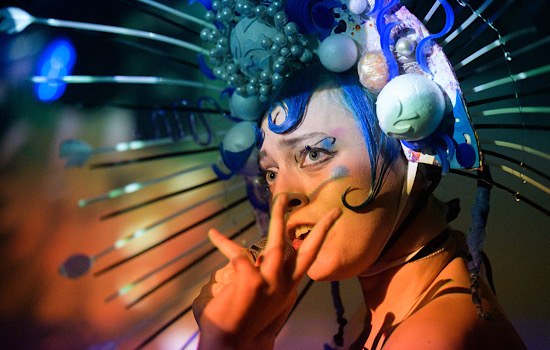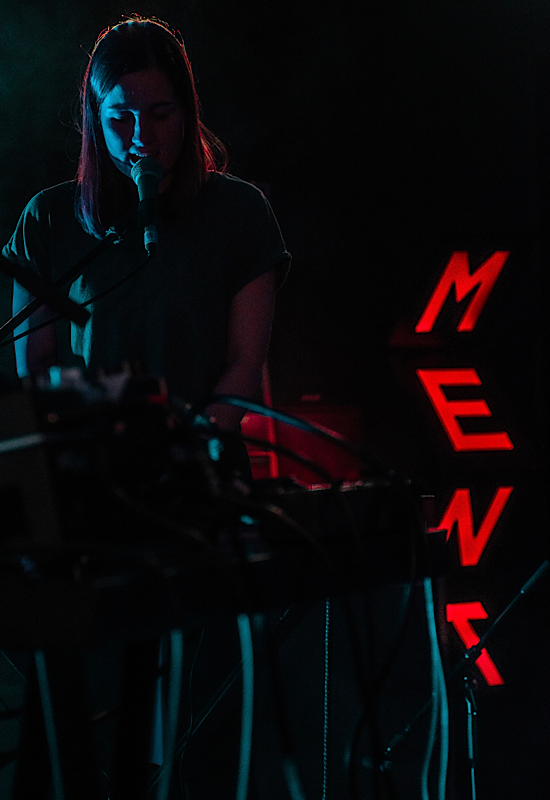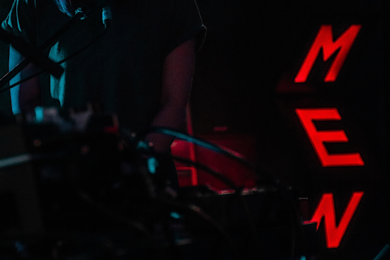Nesen, photo by Marcel Obal
I like stories. The first comes to mind as the plane flies over Ljubljana. We’re flying so close to the peaks of the Kamnik-Savinja Alps, that it feels as if we might land on one. This landscape is a story itself. Slovenia lies at the crossroads of various European routes, acting as a meeting point of cultures. When we land, the road to the capital leads through fields, passing a mountain range.
I hear the second story from Tjaša Ficko, the deputy mayor of Ljubljana, as she opens the ninth edition of MENT. It is a story about culture. "They say to invest in walls, not content," she says, "but I think it is important to invest in both walls and content." She stresses that she prefers to invest in culture, rather than just spend money on it. Later, behind the scenes, we talk about how the tax status for music critics and artists in Slovenia is making them an ‘endangered species’.
The third story is about the Kino Šiška concert hall, which lies outside the city centre but is the heart of the festival – at least until the night-time parties in the clubs on Metelkova Street. I heard about the venue many years ago, and it’s fascinating how it has become part of the European concert network. The day after MENT, The Comet Is Coming play there, but before that, in two rooms – one with a capacity of 1000 and the other of 200 – you can see the freshest European rising bands.
The fourth story is the festival’s curatorial approach, designed to highlight multiple aspects of the Eastern European music scene. The all-day curation Baltic MoMENT explores the Lithuanian, Latvian, and Estonian scenes, while elsewhere, numerous institutions are promoting other countries: Serbia Creates, Croatia on the Move, Hungarian HOTS, LALA Slovak Export, or SoundCzech. If you want to know what’s happening on this side of Europe, you should visit MENT.
Ljubljana’s unique location, where the routes between Austria, Italy and the Balkans meet, dictates the fifth story. Though small, with a population of barely 300,000, the city’s architecture constantly surprises. Sometimes it resembles Prague, sometimes Vienna, and sometimes Amsterdam. Modern cultural institutions on one side, punk squats on the other.
I was told a story of this place a year ago by Širom. Now, I can see and hear for myself. A special mention must go out to Young Researchers, who showed how interestingly you can intertwine minimalism and jazz within a tight 45 minutes, emphasising the aliveness of the vocals, trumpet, and a background of guitar and percussion. Another must be given to a semi-performance of Luka Prinčič’s concert for piano and live coding in the unusual space of the Cukrarna Gallery’s impressive hall; a suave combination of technology and emotional-sounding piano.
Tell me your story
The problem with the contemporary scene is when bands play and sing the same sort of things. When it comes to music in Central and Eastern Europe in particular, it is often said that someone sounds like [insert Western band]. Therefore, what is important to me is often the story behind the music and the lyrics. The duo Puuluup, for instance, who theoretically come from the world of folk but whose music drifts towards pop, write straightforwardly catchy songs, but also capture the genius loci of their native Estonia.
Ramo Teder and Marko Veisson play the talharpas with effects, looping their instruments’ sounds. They weave in elements of folklore, with airy songs the starting point to build multi-layered stories with a 4/4 beat. It’s accompanied by surreal but characterful lyrics about Polish TV heroes, zombies, old Estonian punk, or – what captivated me the most having skied three weeks ago – ‘The Last Country Cross Country Skiier’. There’s an openness on stage and encourage their crowd to have fun. "There are two kinds of people," they say onstage. "Those who dance Estonian dances and those who would like to do so."
Play me your story
Nesen have their pedigree in guitar music – I deliberately do not use the term ‘rock music’ because this is often more of a marker than a description of what lies beneath it. Tas būs ilgi, released two years ago, is an exciting album, neatly combining threads of alternative rock and metal walls of sound, which the band brilliantly translate live into a never-ending musical story with no breaks between tracks.
The ethereal vocals and driving synths of Alise Joste and Karlis Josts interlock brilliantly with an expressive rhythm section and powerful drum juggling from Latvian metal scene regular Janis Burmeisters. The result is a concert with a big dose of heaviness, sweltering rhythmic cascades, and exciting synth crescendos. But it’s also lyrical, the distinctive Latvian language steering these heavy-sounding songs away from the cliche of post-rock pathos. They don’t fall into self-indulgence but build an engaging drama.
How to tell the story
What language to sing in? This is a question that runs through many of the MENT discussion panels. The long-standing trend of non-English speaking countries to sing in English has been changing over the past decade. An interesting discussion arises at Baltic Listening when it’s argued that the languages of the Baltic countries (Latvia, Lithuania & Estonia) are too hermetic. "It’s three different countries, and we don’t understand each other," Ingrid Kohtla of Tallinn Music Week comments. "We never have a Tito to reunite us," she laughs. It shows the different perspectives of each subregion. In the Balkans, it appears easier to communicate than it is in the North. Lyrics can be incomprehensible, but by using their native language, a band gains an authenticity with it, which can be lost in some way when they’re unified to the English language.
The Lithuanian artist Jausmė plays delicate folk songs for the 29-string zither-like kanklės and double bass. "I’ll play the English song so you don’t feel left out," she says before an Adele-like song, but it’s the music she sings in Lithuanian that shows more of her spirit. Treating the voice as a sound, it’s not always necessary to understand the lyrics.
I agree with Christof Ellinghsus of City Slang’s statement that understanding lyrics is not paramount because "what works for me is the package of music and voice." That’s why the tales from the Baltic coast offered by the Superkoloritas – a duo inspired by Lithuanian pop from the ’60s to the ’80s – or the performative psych concert from Elizabete Balčus, who plays flute, loops, and makes music on amplified fruits, works for me.

Elizabete Balčus, photo by Katja Goljat
Care for the story
One of MENT’s additional events, small and intimate but significant, is a discussion about mental health in the music industry. After all, as Rosana Corbacho, a humanistic psychologist specializing in the music industry, points out, the organising of concerts is not all fun – many forget about the burnout and anxiety that comes with it.
Importantly, when talking about mental health, while it is often artists who are placed to the fore, the backroom staff must be considered too. Dr. Arun Castro of Roadie Medic offers a number of tips: do not check emails just when you wake up, keep an eye on your working hours, set boundaries, and be assertive. Castro recommends graded assertiveness; If you want to know more, I recommend Touring And Mental Health, The Music Industry Manual, published at the end of March.
The other story
The most original and outsider concert occurs on the last day at Stara Mestna Elektrarna, a former power station. Kačis, comprising Ana Kravanja, Samo Kutin (two thirds of Širom), and Tea Vidmar, rely primarily on the vocals of Kravanja and Vidmar, while Kutin’s instrumental accompaniment on lyre and lute is plugged straight into the amplifier, which produces a stirring, delayed effect.
The vocalists sing in humming polyphonies and treat the voice as an instrument – at times it has a monotonous yet hypnotic sound, at others it’s a breathy rhyming and chanting, sound. They evoke Meredith Monk’s theatricality and Maja Ratjke’s explorations, but maintain this music’s intimate and natural character. There’s no pretentiousness as they move closer and further away from the microphones, thumping their chests to create punctuating vocalizations; it’s a mystical experience. A more natural space would have heightened the effect, but the overtone was powerful enough. Here there are no words, language, or package at all, just subtle vocal melodies. But the message is clear, poignant, and understandable enough.



